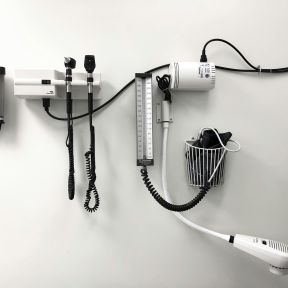
Hypochondria
Hypochondria, or hypochondriasis, is a condition of extreme, preoccupying worry about having a medical disease or developing an illness. Patients experience not only distressing somatic concerns (bodily complaints) that are unexplained medically but abnormal thoughts, feelings, and behavior. For example, patients typically have persistent beliefs about the seriousness of normal bodily sensations and spend excessive amounts of time pursuing a diagnosis of their physical concerns. Their distress is real.
Although hypochondria is a term widely understood, it is not an officially designated term. Instead, the name Illness Anxiety Disorder is used when the symptoms are primarily generalized worries about health and normal body sensations are interpreted as troublesome or threatening illness; patients are preoccupied with the idea that they might be or get sick. Somatic Symptom Disorder obtains when the worry manifests in bodily symptoms that accompany the belief that a physical illness is present, if only the right doctor could find it. Patients are preoccupied with having a specific disorder.
In both cases, psychological distress seeks expression in physical symptoms and sensations, and both types of patients are frequent users the medical care system, although a subset of those with illness anxiety may avoid doctors altogether so that their worst fears remain unconfirmed. Approximately 5 percent of all general medical outpatient visits are attributed to hypochondria.
Contents

Almost everyone worries intermittently about illness. People with hypochondria live in dread that they have a serious disease. The symptoms they worry over can manifest anywhere in the body. A headache is proof of a brain tumor. Stomach pain is a sign of pancreatic cancer. A sore muscle indicates multiple sclerosis. Hypochondriacs search for proof online or by going to doctors, often “doctor-shopping” from provider to provider.
Somewhere between 5 to 10 percent of people are thought to have hypochondria, but doctors find their practices disproportionately burdened by such patients, who may repeatedly call with every complaint and concern. More females than males have the disorder, and it generally begins in middle adulthood. In children, the disorder manifests in recurrent abdominal pain or headache.
Patients with Illness Anxiety Disorder or Somatic Symptom Disorder spend a great deal of time monitoring body sensations and visiting doctors. They spend considerable time seeking health information online, feeling distressed after online health research, and then making appointments for doctor visits—a phenomenon sometimes dubbed cyberchondria. They specialize in self-diagnosis and frequently demand medical tests, even when their doctor considers such tests unnecessary. As a result, they may have medical bills 10 times the national average.
Nevertheless, they are not reassured when their doctor reports that no medical problem can be found, and they may be consistently disappointed or even angry with their physician for failing to find an illness. They are likely to consider their doctor unskilled and uncaring. They may go from doctor to doctor (“doctor-hopping”) seeking diagnosis of the illness they fear is eating away at them. Many researchers who have studied the condition believe that people with hypochondria are looking more for care and concern than for cure.
Do you repeatedly check yourself for signs of illness? Do you fear that your sore throat is a sign of throat cancer or that your cough is the sure sign you have pneumonia? Do you think a lot about your health and talk more than most people about it? Do you spend a lot of time online searching for the causes of your physical sensations and symptoms? Are you sure your doctor is overlooking something important? Do you worry that death is just around the bend? Do you go from doctor to doctor seeking medical tests? Or do you avoid going to doctors altogether, because you don’t want you worst fears confirmed?
Body vigilance is a hallmark of health anxiety, repeatedly scanning for abnormalities. There is evidence that people with illness anxiety, like people with generalized anxiety disorder, are overly attuned to normal body sensations and overinterpret them as signs of catastrophic medical disorders. Cognitively patients are convinced that a real disorder is developing, undetected by medical experts. In fact, medical reassurance is often counterproductive, prompting a renewed search for correct diagnosis.
Hypochondriacs typically have high levels of anxiety and are convinced they have an illness. They believe their concerns about their health are legitimate. They are not engaging in denial; they have a rock-solid belief in organic causes of disorder. Their certainty that a medical problem exists undetected makes them impervious to reassurance from physicians they visit that they are OK. They exist in a closed loop of conviction. And live in a state of terror that death is imminent.
There is no benefit to patients being told that they are hypochondriacs. The term is received as a form of dismissal, a sign they are not to be believed. It compounds their insistence that the malady they have remains undiscovered, confirms their belief that their doctor just isn’t skilled enough to find the real problem, and bolsters their drive to be believed—by the next doctor they visit. As a result, the underlying anxiety grows without being identified or addressed.
Hypochondria is not a voluntary condition. Hypochondriacs do not consciously will their symptoms of distress to manifest in their body or in concerns about their body. Not only are the symptoms not under voluntary control, they typically interfere with the person’s life; the obsessive worry often prompts them to limit participation in many pleasurable experiences and activities.
There is some evidence that, like many people who suffer from anxiety, those who develop hypochondria misinterpret normal body twinges and sensations as indicators of dire internal developments. They may be especially attuned to normal body sensations —in the lingo of science they have especially acute interoception—and overinterpret them as signs of disorder.
Traditionally, hypochondria has always been a diagnosis of last resort—a condition deemed present when a medical explanation is absent, that is, when doctors find no cause for a patient’s symptoms after much searching and testing. That perspective leads to diagnosis by default. And it tends to encourage patients in their determination to find a cause for physical symptoms, pitting patients against doctors in a search for certainty. The new perspective is that hypochondria is a specific form of anxiety—health, or illness, anxiety and the persistent concern with bodily symptoms is a somatic manifestation of anxiety, a disorder that always has physical components..
Increasingly, physicians are administering some form of questionnaire to selected patients in primary care settings to determine whether they have health anxiety and to what extent. The most common test is the Whitely Index (Do you worry a lot about your health? Do you often have the symptoms of a very serious disease?).
Numerous self-tests for hypochondria can also be found online. They are questionnaires that typically ask people to check statements that apply, such as, I worry more than most people I know about having a serious illness, disease, or medical condition; I frequently check my body for signs of illnesses, diseases, or medical conditions; and I avoid certain people, places, things, or situations for fear of disease or illness. The self-tests assess four specific aspects of hypochondria: obsession related to health, behavior relating to seeking reassurance about one’s health, fear of death, and worry about illness.
The diagnosis of hypochondria presents a dilemma. Most patients present themselves to primary-care physicians to conduct an objective search for evidence of pathology. Studies show that primary-care doctors often suspect hypochondria when patients show fears of disease, bodily preoccupation, and urge more testing despite absence of concrete findings—but do not make the diagnosis because they limit their search to concrete causes or know that patients often resist referral for psychiatric treatment. Unfortunately, the real condition is undiagnosed and untreated, and the patient’s searching and suffering continue. Hypochondria is often a diagnosis made in frustration after testing fails to turn up evidence of physical malady.
According the latest edition of the Diagnostic and Statistical Manual , illness anxiety disorder is diagnosable when the following conditions have existed for six months or more:
• preoccupation with having or getting a serious illness
• there are no somatic symptoms or only mild ones
• there is a high level of anxiety about health and the person is easily alarmed about his or her health
• repeated checking of one’s body for signs of illness and other excessive health-related behaviors—or avoiding doctors entirely.
At least 25 percent of all visits to primary-care physicians—and 50 percent of visits to secondary-care doctors—are for medically unexplained symptoms, more often by women than by men. For both patients and doctors, it is a negative experience. The therapeutic challenge to doctors often results in frustration, patients are often deemed “difficult,” and there is often a presumption of psychosocial origin of symptoms.
What distinguishes hypochondria from medical conditions for which no cause can yet be found is the nature and degree of distress patients experience. Hypochondria is marked by excessive thoughts about the seriousness of the illness, the disproportionate levels of time and energy devoted to the symptoms, the appraisal of symptoms as highly threatening, belief in the catastrophic nature of the underlying condition, and disruption of daily life due to the distress over the symptoms.

Hypochondria exposes the weakness of a medical system that divides disorders by whether they are expressed in the body or the psyche, when most conditions are collaborative ventures between mind and body, only to differing degrees. The consequence is that conditions presented to the division of the healthcare system that looks only for somatic causes must, by definition, be deemed nonexistent—not real—when diagnostic search yields no objective evidence of illness. Referral to a psychiatrist is often seen by patients as a rejection of the validity of their suffering.
There is no question that the physical distress hypochondriacs experience is real, as is their emotional anguish. They want their pain and suffering to be acknowledged as real by physicians and those around them. They appear to have heightened perception of and sensitivity to the inner workings of their own bodies (interoception), so that what others experience as a little twinge for them has more power and staying power. As with other forms of anxiety, the very real physical and psychological components of the condition intensify each other.
Normal somatic sensations are thought to play a significant role in hypochondria, or health anxiety. Anxiety propels systems of awareness to go on high alert for danger. In health (or illness) anxiety, the vigilance that is a characteristic of all anxiety is focused on the body. Under extreme surveillance, given a mind on the lookout for and attuned to negative outcomes, every little twinge, no matter how benign, is mentally magnified and becomes a sign of impending medical disaster. That soreness in your chest? Must be a heart problem. Abdominal cramps? Colon cancer, no doubt.
What is more, there is evidence that those prone to anxiety are especially sensitive to body sensations—they are especially aware of and pay more attention to bodily sensations than others. The phenomenon is called interoceptive sensitivity. Further, those normal body sensations are deemed intolerable, a conduit to catastrophe ahead. That is a misinterpretation, a cognitive distortion, but it nevertheless plays a role in creating the real terror that hypochondriacs experience.
It goes without saying but bears remembering that the mind and the body are connected in many ways, not all of them well understood. Hypochondria is a manifestation of one of those ways. Hypochondria is thought to reflect somatization, a phenomenon that is best understood as the mind speaking in the language of the body. Sometimes disturbing thoughts and feelings express themselves in physical upsets, as is often the case in childhood.
The exact mechanism mediating this translation process are not known. Nevertheless, almost everyone experiences some degree of somatization. All conditions have both mental and physical components. Think: tension headache. For some people, the physical components may be more recognizable or more acceptable than the mental ones.
Up to 50 percent of primary-care patients present with physical symptoms that cannot be explained by a general medical condition. That makes encountering medically unexplained symptoms—a sine qua non of hypochondria—a frustrating situation for doctors. Doctors further face a dilemma when encountering patients with illness anxiety. If they accept the symptoms at face value and take on the burden of exhausting all avenues of search for objective evidence of physical disease, they fail to acknowledge the subjective distress of patients. Further, they miss the opportunity to inform patients about the real origins of much disease—a dynamic interaction of biological and psychological processes.
The more aggressive the search for somatic causes, the more physicians reinforce patients’ fears of illness. If patients believe only in physical causes of bodily symptoms, then doctors who fail to find a physical cause and consider psychosocial origins cause disappointment in their patients. They then risk being seen as not taking complaints seriously or considering them as real.

Hypochondria is a baffling disorder. No one knows for sure what makes some people especially prone to express distress exclusively through physical complaints. Or why people persist in believing that they have a medical disorder after being repeatedly reassured by physicians that they are fine. But it is well-documented that many people with illness anxiety refuse referral to mental health specialists, resisting seeing their symptoms as having a psychological origin.
If the tendency to focus on somatic complaints is a prerequisite for hypochondria, then stress is often a catalyst. In particular, one identified catalyst is personal tragedy, such as the death of a loved one. Or it could be the death of a friend who has succumbed to a common, or uncommon, disease. Even news reports about a disorder have been known to trigger hypochondria. Another trigger may be the personal experience of a symptom—a memory lapse, a shooting pain in the chest—well-identified with a disorder considered a major threat to longevity. An online search for information may convert curiosity to conviction that something is wrong.
There is no gene for hypochondria, just as there is gene for general anxiety. There is, however, some evidence that hypochondria is more common in those with a parent who has the disorder. But familial transmission does not necessarily implicate genes. There are many ways families develop their own codes of behavior and pass them on to the next generation. Ways of expressing emotions in general and distress in particular are often among them. Parents who tell children such things as “they’ll be no anger [or sadness] in this house," are laying the groundwork for alternate pathways of expressing emotional distress. Parents who worry about their children’s health and take elaborate precautions to ward off every sniffle may, through their acts of overprotection, be directly demonstrating to their children how to worry about their own health.
A number of factors in addition to recent life stress have been linked to development of hypochondria. As with general anxiety, illness anxiety is linked to the personality trait of neuroticism, the tendency to respond to experience with negative affectivity—that is, distressing thoughts and worrisome feelings—and to be roiled by them. In study after study, neuroticism predicts susceptibility to both anxiety and depression and, to a lesser degree, all other mental disorders. Scientists believe that neuroticism reflects emotional reactivity that is especially attuned to threat.
There is also some evidence that adults with hypochondria in adulthood are more likely than others to have experienced serious illness in childhood or had a sibling who experienced such illness. It is thought that such an experience might be a conduit for perceiving apparent benefits of being sick, such as receiving attention.
Hypochondria is more common among those who have experienced a recent stressful life event than in those who have not. Many are the ways that anxiety and stress are related within. Anxiety is the name given to the internal sensations of warning generated by the body’s reaction to perceiving a mental or physical threat. The sensations are set in motion by the stress response (or fight-or-flight) system, whose job is to alert us to and protect us from danger. The stress response includes chemical warning signals, such as cortisol and adrenaline, sent to various organs, jolting us to pay extra attention to signs of danger. By altering the function of neural circuits in the brain—orienting attention to negative developments and biasing interpretation of neutral events toward the negative—stress can overwhelm a person’s ability to exert control over t their thoughts.
As a form of anxiety, hypochondria is both a mental and physical state of negative expectation. Mentally it is characterized by increased apprehension manifesting as worry, and physically by activation of multiple body systems, all standing by to counter possible harm. The body sensations of anxiety are felt as unpleasant and are mentally misinterpreted and magnified, exacerbating distress.
Not only are the body sensations misconstrued as signs of impending doom, but they lead to odysseys of search for a medical cause. Physical symptoms are assumed to be the result of physical causes, and in a misdirected search for a physical cause, the true source of the problem continues undiscovered and unaddressed. Illness anxiety a is a disorder when it disrupts daily life, limits engagement with normal and even pleasurable activities, and the worry consumes a disproportionate amount of mental space. The condition is often accompanied by depression.

Until recently, hypochondria—the conviction some people have that they are suffering a serious undiagnosed illness— was considered a disorder beyond the reach of treatment. But in the past decade or so, the components of the condition have come into clearer focus— belief in the presence of an undiagnosed disease, health-related anxiety, bodily preoccupation. The misperception of benign body sensations and the distorted thinking that magnifies and misattributes them have led researchers and clinicians to see the value of psychological treatments.
Nevertheless, physicians report that hypochondria remains a difficult disorder to treat, in part because it is difficult to orient patients to the right treatment. Patients with illness anxiety spend a great deal of time in the medical system. They overutilize medical services and remain anxious even when diagnostic procedures turn up no evidence of illness. They literally don’t take no for an answer; it does not give them reassurance. Many resist seeing their problem as inherently psychological, because they believe it means their suffering is not “real.”
The challenge for any treatment of hypochondria is to educate patients about the nature of their disorder and what triggers it. Beyond that, the treatment of choice for hypochondria, or Illness (health) Anxiety Disorder, is psychotherapy, because it specifically targets the perceptual and cognitive mechanism thought to underlie the disorder—and in particular, cognitive behavioral therapy (CBT). There is a mountain of evidence documenting the effectiveness of CBT for generalized anxiety and other anxiety disorders. And as with other anxiety disorders, the antidepressant drug fluoxetine (Prozac) is sometimes al so used to treat health anxiety.
Research has shown that CBT successfully teaches hypochondriacs to identify what triggers their behavior and gives them coping skills to help them manage it. In one well-regarded, randomized, and controlled study, patients assigned to CBT received treatment in six 90-minute sessions at weekly intervals. At both 6-month and 12-month follow-up, CBT patients logged significant reductions in hypochondriacal thought frequency, health anxiety, and amplification of body sensations. They also were better able to participate in the normal activities of daily living.
The treatment didn’t necessarily eliminate somatic symptoms. But it does help patients reduce their fears and bolster the ways they cope with them. Still, there’s a rub: The treatment is effective only if people undergo it—and only 30 percent of patients offered any form of psychosocial treatment accepted it. The majority of those with hypochondria believe in a physical solution to their somatic symptoms.
CBT takes aim at several facets of hypochondria at once. At its heart, CBT targets distorted thoughts, such as the expectation of disastrous outcomes. Patients are taught, for example, to examine the evidence for and to challenge their automatic thoughts, rather than to accept them at face value. They learn to identify all-or-nothing thinking, jumping to conclusions (That pain in my arm means I’m having a heart attack), catastrophizing from tiny bits of evidence, ignoring or discounting positive evidence, and other thought distortions that incline the mind negatively. Patients also learn alternative ways of dealing with uncomfortable physical symptoms, such as diaphragmatic breathing and muscle relaxation.
Because many sufferers are unwilling to acknowledge the role anxiety plays in their symptoms, they are not always willing to seek help from a mental health professional. That opens the door very wide for self-help strategies. The most significant might be to avoid online searches for bodily symptoms, so that the pain in your gut is not a sure sign of a rare tumor. Cyberchondria is real and those with health anxiety spend more time online searching for health information only to be persuaded that they have some rare disorder. There are other actions worth considering:
• Take a step back and always examine the full range of evidence that your headache signals a brain tumor or your gastric upset definitely means pancreatic cancer
• Learn stress management and relaxation techniques to deploy when somatic symptoms grab your attention
• Cultivate activities you feel passionate about. For any kind of anxiety, diversion is often the best medicine
• Make and stick with a plan to see your primary-care physician only once or twice a year; put the appointments on your calendar.
Hypochondria, like other anxiety-based conditions, is considered a chronic condition that is stable over time. Still it can ratchet up in intensity, exacerbated by stress and traumatic events. Studies show that even with the best of treatments, the tendency to experience somatic symptoms persists, but behavioral therapy can reduce their intrusiveness and minimize their ability to disrupt life.
Hypochondria is especially dangerous to financial health. It drives up medical costs for the person suffering health anxiety and for the population in general, because it overburdens the medical system with unnecessary procedures. The condition also poses a risk to general health, as patients undergo more diagnostic and surgical procedures than are medically necessary, and all of them carry some risk.
If untreated, mental illness in general, and anxiety in particular, can progress in symptom severity. Because anxiety shares many of the same neural pathways as pain and commonly co-occurs with it, anxiety exacerbates the perception of pain and increases the risk of disability from it. Further, anxiety activates the stress response, and the hormones of stress repeatedly batter body and brain, leading especially to memory problems due to toxic effects of stress on the brain. Anxiety typically interferes with sleep, and through chronic insomnia, untreated anxiety can undermine body systems of metabolism and immune protection.
But the biggest cost of untreated illness anxiety may be that is robs life of joy and takes a huge toll on relationships. Those with hypochondria spend an inordinate amount of time going to doctors, worrying about their health, and seeking reassurance from those around them—and always falling short of what they seek. The disorder shrinks people’s lives—one reason it so often leads to depression.














